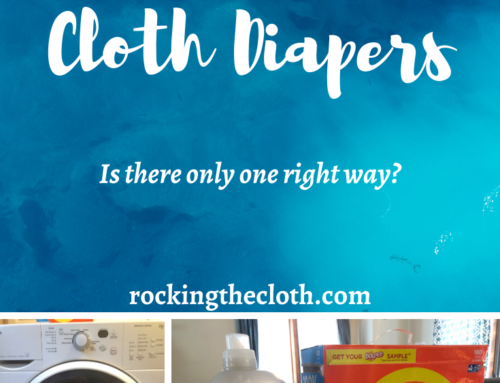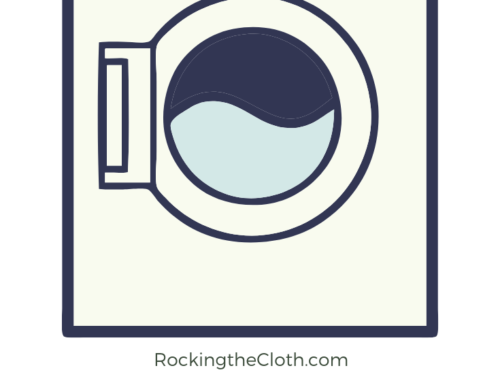Are your cloth diapers leaking? Leaking is one of the most common issues with cloth. In general, cloth diapers do not leak. If someone tells you, “That’s just what cloth does!” or “That’s why I use disposables!” they are incorrect.
Good quality cloth diapers that are taken care of should not have any issues with leaking. However, it does happen from time to time when certain problems arise.
If you are dealing with leaking diapers, consider the following to fix your issues.
Why Are My Cloth Diapers Leaking? 1st: Check the Fit

Check your leg openings. When you put it on your baby and then move your baby’s legs around, do you see any gaps?
Leg gaps can be caused by the following: the rise is too high, the waist is too loose, your baby is still too small for that size of diaper (for example, a newborn in a one-size diaper may have issues with leg gaps), your diaper is stuffed too full with inserts, your baby has chicken legs and your diaper brand works better for thicker legs.
If you have leg gaps, that is probably why you have leaks. Work on adjusting the fit of your diaper by whatever means necessary.
If you don’t have leg gaps, consider if your waist is too loose. Your waist doesn’t have to be tight (you should be able to easily slide your fingers in the waist), but if it is too loose, you run the risk of leaking out of the top of the diaper. This can happen during naps or tummy time.
Make sure your waist is fastened an appropriate amount–not too tight, but not too loose.
In these pictures, you can see that there are no leg gaps in my fit. Of course, my “baby” is 2.5 now, and he has chunky thighs, so leg gaps are rarely an issue for him. My first child, however, had the skinniest legs! We struggled with leg gaps with him while trying to find the right fit.
Check Your Creams
Certain diaper creams are not appropriate for cloth diapers because they may not wash off properly. When you have a cream that doesn’t wash off well, over time it will build up enough to cause repelling and not allow urine to be adequately absorbed.
Check out this post for cloth diaper-safe creams. Alternatively, you can use your favorite cream, but you will want to make sure you use either a disposable or reusable liner between your baby and the diaper to protect the diaper.
Reconsider Your Inserts

Microfiber is a cheap insert material that comes standard with many brands of diapers. It’s cheap, it’s absorbent….but it’s not without its issues.
Microfiber is prone to something called compression leaks. That means that while it can hold a decent amount of urine, even a slight bit of pressure could cause the liquid to be squeezed back out if it gets too full.
There are also other insert materials, like bamboo or hemp, that can hold more than microfiber.
Another issue you will want to consider with your inserts is if they are too bulky. Like I explained earlier, too much bulk could potentially cause fit issues with leg or waist gaps.
If your inserts aren’t bulky at all, then you could possibly double them. Try layering two together and double stuffing the diaper to see how that goes. It will be bulkier than it was before, but as long as it doesn’t cause fit issues, they are fine.
A lot of people worry about bulkiness being uncomfortable for the baby. Most of the time, babies do not find bulky diapers uncomfortable. That is an adult projecting their worries onto the baby. 😉 (Within reason, of course. You can certainly get out of control with bulk if you try. But if your diapers aren’t bulky enough to first cause issues with fit, then they likely aren’t bulky enough to be uncomfortable).
However, all babies are different. Your baby may be more sensitive to the size of their diaper than other babies are. If you feel your baby is truly bothered by a double-stuffed diaper, then move on to different insert materials.
Do An Absorbency Test

If you used products on your cloth diapers that are not approved, like certain diaper creams, fabric softeners, etc., you could be setting your diapers up to repel liquids. This may also happen if you wash in extremely hard water without any added water softeners (water softeners=okay, fabric softeners=bad).
An absorbency test is simple. Start with a cup of water (I like to measure out one cup so that I can keep track of exactly how much I have poured on the diaper). Slowly pour the water over the center of the diaper. Try not to pour much faster than you think your child may urinate to keep results consistent and to be able to see when the diaper is not absorbing as well anymore.
You may notice that water is not absorbing well at all and instead is rolling off to the sides. This means you have an issue with repelling and you will want to strip your diapers to remove the build-up of the unwanted materials.
An absorbency test will also help you know how much your diapers can truly hold and you can decide if that is realistic for your child. Some babies are heavy wetters, meaning they tend to hold their pee a little longer at one time, so when they do pee, they pee much more than other babies. This can overwhelm the absorbency of some diapers.
I did a quick absorbency test on the diaper above. It is an all-in-one with some bamboo and some microfiber. It easily absorbed about a cup of liquid, maybe slightly more. I would consider that an average absorbency. Some will be less, certain kinds (like fitteds, hemp inserts, etc) will hold more.
Both of my kids went through periods of heavy wetting when they were infants. Once they were toddlers and not on a completely liquid diet, they had fewer issues with overfilling their diapers (other than at night).
Check Your PUL

If the PUL is cracked or delaminated, unfortunately, that diaper cannot be used anymore. There isn’t a great way to fix PUL. It is time to recycle that diaper shell at a proper clothing recycling facility.
You Can Find A Solution!
Leaking can be frustrating, but do not give up on your cloth diapers! There is always a solution. If you have read these items and still cannot figure out the issue, feel free to email me at [email protected] and I would love to help you.
Have you ever dealt with leaking issues? How did you fix it? Let us know in the comments!






Some materials (such as microfiber or stay-dry fabrics) need compression in order to absorb. If you pour water onto a diaper with a stay-dry layer of suedecloth, it’ll likely bead up and the water will roll off, giving the appearance of an absorption issue. So it’s important to take that into consideration before worrying that your diapers are repelling! 🙂
Thanks! Good idea to use your hand a bit to help make sure they will or won’t absorb.
Thanks so much for posting this informative article, I love the fact that it is addressing a very practical issue and I’ve learned a lot from it. Leaking diapers can be frustrating sometimes. It is nice that you explained in detail how to troubleshoot the issue and explore ways to avoid leaking. This will be very helpful.
Thanks!
Hey Holly, Thank you for writing on Cloth Diapers Leaking? Troubleshooting Tips & Tricks. I enjoy while reading your post and find many helpful info to stop diapers leaking. Your guide is very helpful to diapers leaking. You listed in details as well as absorbency test guide is also awesome. Now we do absorbency test while choose the diapers. Thank you
Parveen
Thanks Parveen! Glad you found it helpful.